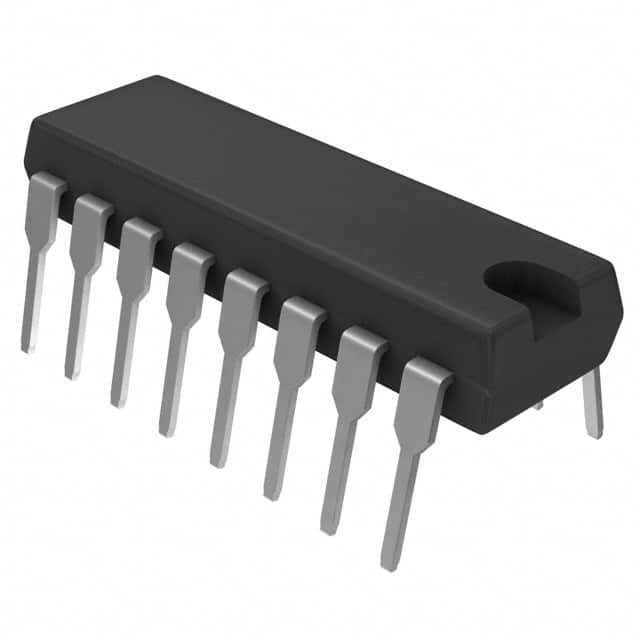Voir les spécifications pour les détails du produit.

MM74HC589N
Product Overview
- Category: Integrated Circuit (IC)
- Use: Shift Register
- Characteristics: High-Speed, Serial-In Parallel-Out (SIPO), 8-Bit Register
- Package: DIP (Dual In-line Package)
- Essence: The MM74HC589N is a versatile shift register IC that can store and shift data in an 8-bit parallel format.
- Packaging/Quantity: Available in tubes or reels, with varying quantities depending on the supplier.
Specifications
- Supply Voltage: 2V to 6V
- Operating Temperature Range: -40°C to +85°C
- Input Compatibility: TTL, CMOS
- Output Compatibility: TTL
- Clock Frequency: Up to 25 MHz
- Number of Stages: 8
- Data Format: Parallel-In, Serial-Out (PISO)
Detailed Pin Configuration
The MM74HC589N has a total of 16 pins, each serving a specific function:
- Pin 1: Serial Data Input (DS)
- Pin 2: Clock Input (CP)
- Pin 3: Master Reset Input (MR)
- Pin 4: Output Enable Input (OE)
- Pin 5: Parallel Data Inputs (D0)
- Pin 6: Parallel Data Inputs (D1)
- Pin 7: Parallel Data Inputs (D2)
- Pin 8: Parallel Data Inputs (D3)
- Pin 9: Parallel Data Inputs (D4)
- Pin 10: Parallel Data Inputs (D5)
- Pin 11: Parallel Data Inputs (D6)
- Pin 12: Parallel Data Inputs (D7)
- Pin 13: Serial Data Output (QH')
- Pin 14: Clock Inhibit Input (CI)
- Pin 15: Ground (GND)
- Pin 16: Positive Supply Voltage (VCC)
Functional Features
- Serial-In Parallel-Out (SIPO): The MM74HC589N allows data to be serially input and then parallelly output.
- Parallel Data Storage: The IC can store data in its 8-bit register, allowing for easy retrieval and manipulation.
- High-Speed Operation: With a clock frequency of up to 25 MHz, the MM74HC589N enables rapid data transfer.
- Input/Output Compatibility: It is compatible with both TTL and CMOS logic levels, making it versatile in various circuit designs.
Advantages and Disadvantages
Advantages
- Versatile shift register suitable for a wide range of applications
- High-speed operation allows for efficient data transfer
- Compatible with both TTL and CMOS logic levels
- Easy integration into existing circuits due to standard DIP package
Disadvantages
- Limited number of stages (8) may not be sufficient for certain complex applications
- Requires external components for proper functioning (clock source, power supply, etc.)
Working Principles
The MM74HC589N operates based on the principle of shifting data through its internal register. When the clock input (CP) receives a pulse, the data at the serial input (DS) is shifted into the first stage of the register. Subsequent clock pulses shift the data through each stage until it reaches the last stage. At this point, the data can be accessed in parallel from the eight output pins (Q0-Q7).
Detailed Application Field Plans
The MM74HC589N finds applications in various fields where data storage and manipulation are required. Some potential application areas include:
- Digital Communication Systems
- Data Processing Units
- Industrial Automation
- Robotics
- Automotive Electronics
Detailed and Complete Alternative Models
- SN74HC595N: 8-Bit Shift Register with Serial-In Parallel-Out (SIPO) functionality.
- CD4015BE: Dual 4-Stage Static Shift Register with Serial-In Parallel-Out (SIPO) functionality.
- 74LS164: 8-Bit Serial-In Parallel-Out (SIPO) Shift Register.
These alternative models offer similar functionality to the MM74HC589N and can be used as substitutes depending on specific requirements.
Word count: 460 words
Énumérez 10 questions et réponses courantes liées à l'application de MM74HC589N dans les solutions techniques
Sure! Here are 10 common questions and answers related to the application of MM74HC589N in technical solutions:
Q: What is MM74HC589N? A: MM74HC589N is a 8-bit shift register with input latches and 3-state outputs, commonly used in digital circuits.
Q: What is the purpose of using MM74HC589N in a circuit? A: MM74HC589N can be used to expand the number of available inputs or outputs in a digital system.
Q: How many bits can MM74HC589N handle? A: MM74HC589N is an 8-bit shift register, meaning it can handle up to 8 bits of data.
Q: Can MM74HC589N be cascaded to handle more than 8 bits? A: Yes, multiple MM74HC589N chips can be cascaded together to handle larger numbers of bits.
Q: What is the maximum clock frequency supported by MM74HC589N? A: The maximum clock frequency supported by MM74HC589N is typically around 25 MHz.
Q: Can MM74HC589N be used for both serial-to-parallel and parallel-to-serial conversion? A: Yes, MM74HC589N can be used for both serial-to-parallel and parallel-to-serial conversion depending on the configuration.
Q: What is the power supply voltage range for MM74HC589N? A: The power supply voltage range for MM74HC589N is typically between 2V and 6V.
Q: Does MM74HC589N have built-in protection against electrostatic discharge (ESD)? A: No, MM74HC589N does not have built-in ESD protection. External measures should be taken to protect the chip.
Q: Can MM74HC589N drive LEDs directly? A: Yes, MM74HC589N can drive LEDs directly through its 3-state outputs with appropriate current-limiting resistors.
Q: Are there any specific precautions to take when using MM74HC589N in a circuit? A: It is important to ensure proper decoupling capacitors are used near the power supply pins of MM74HC589N to minimize noise and voltage fluctuations.
Please note that these answers are general and may vary depending on the specific application and requirements.

